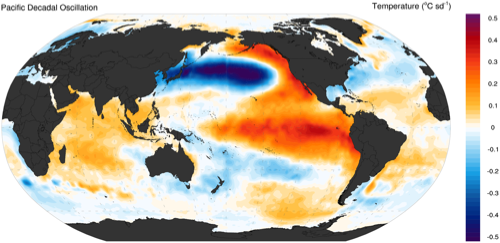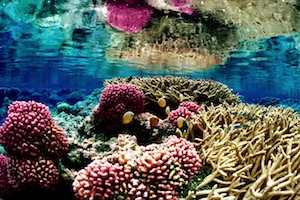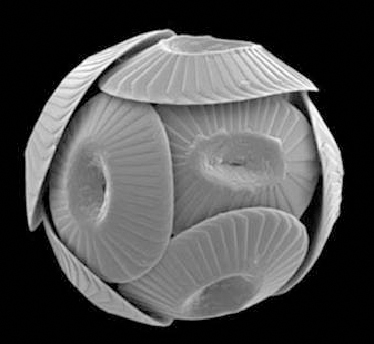Ocean acidity is closely linked to carbon dioxide levels (Wikipedia). Increased carbon dioxide levels in the atmosphere can obviously lead to increased carbon dioxide concentrations in the ocean, but the process is more complex than scientists originally believed. Wind and weather patterns affect the flow of water within the oceans. Two important such patterns are the North Atlantic Oscillation and the Pacific Decadal Oscillation, both of which help circulate ocean water. About two decades ago, the NAO brought more winds to the Atlantic Ocean, bringing to the surface water that was unsaturated with carbon dioxide and thus able to dissolve more from the atmosphere. However, the PDO in its cold phase increases the amount of upwelling, or the movement of carbon dioxide-rich water to the surface. This upwelling allows the ocean to release carbon dioxide into the atmosphere.
This gradual change of increases and decreases in ocean carbon dioxide levels corresponds directly to changes in ocean acidity, which may effect the survival of various marine organisms. It is predicted that by the end of the century the carbonate chemistry of the ocean will change more than it has in the last 20 million years.
It is predicted that by 2050 the concentration of CO2 in the atmosphere will exceed 500 ppm, an increase of more than 80% from pre-industrial times. This will affect not only ocean temperature, but is also predicted to increase the average acidity of the ocean surface by more than 60% over just a 300 year time span.

Our knowledge of how this change in ocean acidity will affect marine life is not extensive. Climate change and CO2 production will lead to a gradual decrease in the pH of the ocean by an estimated 0.5 units over the next century. Most studies related to how acidity affects a species have been short term and involve significant deviations from the pH that a species is used to experiencing. Therefore, these studies do not say much about how marine life might be affected by more gradual, long term pH change. Also, due to the diversity of marine life and their abilities to respond to this change, it is hard to make an accurate general prediction of how marine life may be affected by changes in ocean acidity.
It then seems that a good starting point for future research would be to pinpoint these basic physiological processes that allow for such diversity in organismal responses to changing acidity in the ocean. In addition, some of the diverging data may be caused by differences in experimental methods and models. A unified structure of conducting experiments regarding acidity would help with this problem.
So far, acidity has been looked at most closely in terms of how it affects calcifying organisms, primarily coral. This is because changing pH levels will affect these organisms the fastest and potentially the most drastically and because coral reefs are such an intrinsic part of many marine ecosystems. It is likely, too, that the larval stages of many marine invertebrates will be particularly vulnerable to changes in ocean acidity.
However, calcifying invertebrates will certainly not be the only marine organisms affected by climate change. Unfortunately, there is very little information and are very few studies focused on an economically and ecologically important group: fish. A survey of 116 studies on how changing acidity and carbon dioxide levels will affect marine fish species present little useful data. Many of the studies used CO2 levels that were much higher than expected to occur in the next century. They focused on short term, extreme changes instead of the gradual, long term changes that are expected to occur. In addition the studies focused almost exclusively on acid-base control and cardiovascular and respiratory regulation. There is virtually no information on how acidity will affect fish reproduction, development, or behavior (Ishimatsu, Hayashi, Kikkawa pg. 295).
Considering how important fish are to us commercially, culturally, ecologically, and even sportingly, this is an area of climate change research that desperately needs to be farther explored.

One of the most important factors in understanding ocean acidification is to observe how it affects an individual organism’s physiology. One of the first things to consider is which organisms are the best experimental subjects. These would be species with the most genomic and molecular data available. These include the purple sea urchin, stony coral, and coccolithophores, like the ones mentioned in this week’s article. Two of the best tests to use to study genomics are quantitative PCR and microarrays (Hofmann, O'Donnell, Todgham pg. 220). Gene expression is perhaps the best way to get an in depth look at how a marine calcifying organism’s physiology will change as the ocean’s acidity increases.
Coccolithophores:
Targeted studies of key individual species are invaluable because each calcifying species will have different responses to changing acidity so their adaptive physiology can show the impact of increasing acidity at the ecosystem level. Study of functional genomics may be the best tool to use to understand the potential organisms will have to adapt to changing ocean acidity. It can also be used to determine if marine calcifiers will have enough plasticity to construct their calcium skeletons in a future with increased ocean acidity.
An important thing to consider is which species will be most vulnerable to future changes in ocean acidity. In determining which species will be able to adapt these to changes, considering a species' scale of phenotypic variation, population turnover rates, and the fitness cost associated with trait variation could be as important as the knowledge of heritability itself (Sunday et al).
Effects of CO2-driven ocean acidification on the early developmental stages of invertebrates:
The main issue surrounding ocean acidification is the fact that an increase in carbon dioxide has also lead to a decrease in both pH and the availability of free carbonate ions available to marine organisms. The goals for this study were to determine the effects of carbon dioxide levels predicted for year 2100 on larval development, to calculate heritabilities and maternal effects under present and year-2100 carbon dioxide conditions, and to compare the potentials for adaptive evolution in larval traits in either species. The thing that caught my attention in this article was the problem that we discussed last week in class: most marine organisms of ecological and economic interest have long generation times, and non-clonal, and have not previously been subjected to multiple generations of artificial selection. After reading this article, I decided to research if any experiments have been done on larger marine organisms. My findings can be found here.

Comments
john wares
Sep 26, 2012
this page is looking really good. expand the link to it on the Introduction page, and you might add the tag "adaptation" since what is here deals with that.